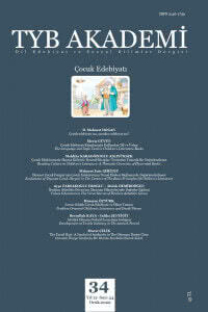Dağıstan Cumhuriyeti’nin Khunzakh Bölgesindeki Avarların Arapça El Yazma Eserleri
Arabic Manuscrıpts of Avars in the Khunzakh Region of the Republic of Dagestan
___
- Al-Kazikumukhi, Abdurrahman. (1997). A book of memories. Makhachkala.
- Al-Karakhi, Muhammad-Tahir. (1990). The brilliance of Dagestani sabers in some Shamil battles. Makhachkala.
- Alibekova, P.M. (2009). Life and creative heritage of Dibir-qadi from Khunzakh. Makhachkala.
- Alibekova P.M. (2014). Dibir-qadi from Khunzakh. A collection of two languages for teaching two brothers. A Persian-Arabic-Turkic dictionary. (Dictionary articles containing Persian poetic texts: translation and commentary). Makhachkala.
- ad-Durgeli, Nazir. (2012). The delight of minds in the biographies of Dagestani scientists. Nuzhat al-’azhan fi taradjim ʻulama’ Dagestan / translated from Arabic, commentary, facsimile ed., indexes and bibliogr. prepared by A. R. Shikhsaidov, M. Kemper, A. K. Bustanov. Moscow: Marjani Publishing House.
- Omarov, A. (1868). Memoiers of mutaalim/Collection of information about the Caucasian mountaineers (SSKG). (Issue 1). Tiflis.
- Saidov M.-S. (Ed). (1977). Catalog of Arabic manuscripts of the Institute of History, Language and Literature of the Dagestan Filial of the USSR Academy of Sciences. (Issue 1). Moscow: Nauka.
- Shikhsaidov A. R. (1999). An important stage in the study of the manuscript heritage of the peoples of Dagestan/Bulletin of the Dagestan Scientific Center. Makhachkala. 96–104.
- ISSN: 2146-1759
- Yayın Aralığı: 3
- Başlangıç: 2011
- Yayıncı: Mustafa Ekici
Dağıstan Cumhuriyeti’nin Khunzakh Bölgesindeki Avarların Arapça El Yazma Eserleri
Hilafetin Ticari İlişkilerinde Güney Kafkasya Şehirlerinin Rolü
Yegane ÇAĞLAYAN, Erhan ÇAĞLAYAN
Bir Trigonometri Risâlesi: İlm-i Müsellesât
Halime Mücella DEMİRHAN ÇAVUŞOĞLU
Nadir Şah’ın Dağıstan’a III. Seferi
Mekândan Belleğe: Çerkezlerin İlk Kadın Yazarı Hayriye Melek Hunç’un Eserlerinde Kafkasya
Türkiye ile Azerbaycan’ın Kafkasların Güvenliği İçin Karabağ Mücadelesi ve Rusya Faktörü
Kafkasya’da Müslüman Olmak: Batum’daki Gürcü Müslümanların Karşılaştıkları Sorunlar
